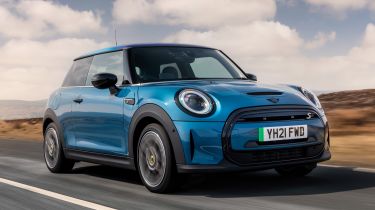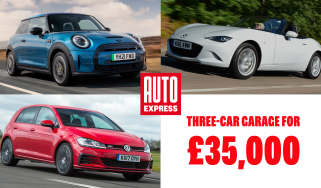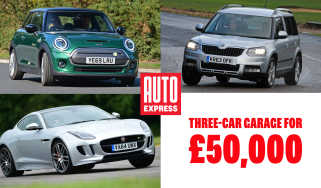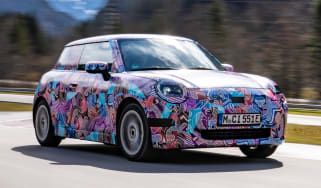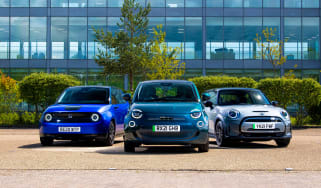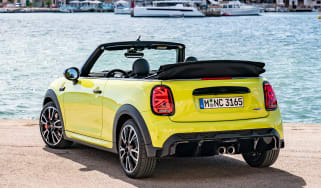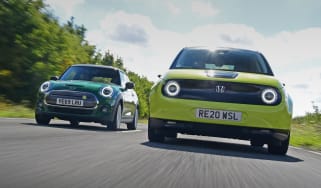MINI Electric (2020-2024) review
Typically stylish, quick and cheap to run, the MINI electric will put a smile on your face - although the limited range spoils the fun

Just so you know, this is an older review of the 2020-2024 MINI Electric. If you are interested in information about the latest MINI Cooper E, or news about the latest MINI models, please follow the links provided.
MINI hasn’t wavered from its core values in delivering the new Electric model. It remains fun to drive, with lively performance and a classy image, while the all-electric powertrain just adds further value to the iconic small car.
The limited range might put off some customers, but the real challenge to sales success for the MINI Electric will come in the form of close retro rival, the Honda e. Both are similarly priced and will travel roughly the same distance on a single charge. But, great design so often wins the day, and it’s a tough choice between the quiet cool of the MINI, or the funky, tech-laden Honda e.
About the MINI Electric
The original MINI was created in 1959 as a response to the global oil crisis. Designer, Alec Issigonis, was charged with producing a small car that created maximum space with minimal dimensions, had room for four people, was good to drive and delivered low fuel consumption. We think it’s safe to say he succeeded.
Used - available now

2022 Fiat
500
12,924 milesManualPetrol1.0L
Cash £10,400
2026 BMW
4 Series
26,030 milesAutomaticPetrol2.0L
Cash £25,997
2025 Audi
A5 Sportback
37,025 milesAutomaticDiesel2.0L
Cash £25,197
2026 BMW
i4
25,438 milesAutomaticElectric
Cash £29,197While ownership of the brand has certainly had its highs and lows, it was in 2001 that a new BMW-owned MINI generation was unveiled, leading to the success story we know today.
For around 20 years, MINI has been the default premium small car. Available in an increasing number of body styles, from regular three-door hatch, to the SUV-styled Countryman and open-top Convertible models, the iconic retro look has been repackaged to appeal to an increasing number of customers.
Now, it’s the turn of the MINI Electric. However, the three-door hatch won’t have it all its own way. The market for small fully-electric cars is growing rapidly, as more people seek cleaner alternatives for their urban driving needs.
Trailblazers such as the Renault Zoe and Nissan Leaf have grown in popularity and led to other manufacturers launching their own take on a small EV. Hyundai has produced the Kona Electric SUV, while Kia has its latest Niro EV, another compact SUV design. In the supermini space, Peugeot’s e-208 also shares a lot of PSA-group tech with the Vauxhall Corsa-e model and these, along with the Honda e and new electric Fiat 500, will be key rivals for the MINI Electric.
With the MINI Electric range starting from around £29,000, it undercuts the Honda e by around £8,000. There are three core trim levels to choose from: Level 1 is generously equipped with a choice of 16 or 17-inch alloy wheels, LED headlights, sat-nav and cruise control. The mid-spec Level 2 trim adds 17-inch alloys of different design, heated seats and a rear view camera, while the Level 3 cars include a panoramic glass sunroof and an upgraded Harman Kardon audio system. MINI has also introduced the Resolute Edition which comes with Rebel Green solid paint, along with bronze-coloured exterior accents and other cosmetic touches.
MINI decided on an early facelift for the Electric model in 2021, bringing it into line with the wider hatchback range. There were changes to the grille and some exterior trim, along with the introduction of fresh paint options, new alloy wheel designs and a top-of-the-range 'Collection' version. Inside, there is a revised infotainment set-up, new buttons for the multi-function steering wheel and extra optional equipment to choose from, such as a heated steering wheel, active cruise control and sun protection glass.
There’s only one power option for the three-door Mini Electric - a 32.6kWh battery powers a single electric motor, producing a total of 181bhp and a 0-62mph time of 7.3 seconds.
As ever though, the question EV customers have to ask themselves is whether their car will fit seamlessly into their daily lives, and the slightly underwhelming range of up to 145 miles may put some off.
Electric motor, drive and performance
By coupling the sporty three-door hatch body style with an all-electric powertrain, MINI has delivered a small car with great performance, and retained most of its famed ‘go-kart’ handling. Our testers noted that the heavier Electric model was still as much fun behind the wheel as any fast MINI they’d driven before.
As with all EV’s the instant acceleration is slightly addictive and, because the car’s centre of gravity is lower than even the petrol Cooper S version (due to battery positioning), it handles pretty well, too.
In addition to providing great entertainment on A- and B-roads, there’s much to be said for the MINI Electric’s ability on the motorway. Pressing the throttle at cruising speeds still delivers a decent amount of oomph, to ensure easy overtaking.
Driving in town might throw up more challenges than you might think, however. The MINI has a bigger turning circle than its Fiat 500 and Honda e rivals, while opting for the Level 1 entry version means you don't benefit from a reversing camera or rear parking sensors.
There are four different driving modes - Sport, Mid, Green and Green+. Most will probably opt to leave the setting in standard Mid mode, as Sport and Green do nothing more than subtly adjust the throttle response, while Green+ reduces the capability of features such as the climate control, which helps to up the range.
One quirk of the MINI Electric is the feel of the regenerative braking system. When you lift off the accelerator pedal, your speed falls quickly, the energy converted back into electricity to be stored in the battery. It takes a little getting used to, although there are two brake settings to choose from.
0-62mph acceleration and top speed
The MINI Electric has a 32kWh battery which enables the motor to produce 181bhp and 270Nm of torque. Performance figures are pretty impressive - 0-62mph is covered in 7.3 seconds, although the more realistic ‘urban sprint’ from 0-37mph is achieved in just 3.9 seconds. Top speed is limited to 93mph.
Range, charging and running costs
The original MINI was designed with low running costs in mind, so it seems apt that the Electric model has again delivered so positively on this brief. A car’s whole life cost starts with its purchase price, and this is where MINI has been very clever. The Electric range starts around from £29,000, which undercuts the Honda e, Peugeot’s e-208 and the Renault Zoe.
There are some other manufacturers that offer similarly-priced, or cheaper all-electric options, however. The Nissan Leaf is available from around £29,000, while the MG4 EV starts from £27,000. Although the 4 EV is sharply styled, neither of these models really offer the fun factor that comes with the MINI.
The claimed maximum range from a fully topped-up battery is 145 miles, although this falls to 141 miles if you choose the high-spec Level 3 car. MINI does offer its own charging card with the Electric model, however, which allows you to access the public charging network from MINI Charging.
Insurance groups
Insurance premiums shouldn’t be too high, as the MINI Electric sits in groups 22-23. By comparison, the Honda e occupies group 25-29 and will cost you more every year to fully insure.
Depreciation
Residual values for the MINI range have generally remained strong over the years, and the Electric stays true to form holding onto an average of 59 per cent of its original list price over three years and 36,000 miles. The Honda e doesn’t quite match up, with around 50 per cent of its value retained over the same period.
To get an accurate valuation on a specific model check out our free car valuation tool...
Interior, design and technology
The MINI Electric three-door hatch looks pretty smart from the outside - 16-inch alloy wheels are standard, as are LED headlights and foglights. The Level 2 cars include heated front seats, power folding door mirrors and a rear view camera, while top-spec Level 3 trim adds leather upholstery, adaptive LED headlights and a panoramic glass sunroof - it’s certainly a smart place to sit.
MINI introduced a facelift for the Electric model in 2021, although changes were mostly cosmetic. The main exterior updates are the inclusion of a wider, body-coloured grille which replaces the previous grey insert, and the deletion of the front fog lights.
Metallic paint is now standard across the range, with the usual personalisation options that you'd expect from MINI. You can choose from different paint colours for the mirror caps and roof, while there are a total of eight different alloy wheel designs on offer - albeit some only available in conjunction with higher trim levels.
Inside the cabin, it’s the usual MINI blend of circular screens, switches and a general high-quality feel to the materials on show. There is also the new digital display from the latest MINI GP Works model in front of the driver.
All versions include a leather-trimmed sports steering wheel with multi-function controls, while there are flashes of yellow dotted around the interior trim to remind you that you’re driving the Electric model. The 2021 facelift saw the inclusion of fresh buttons for the multi-function steering wheel and a revised infotainment set-up, along with a top-spec Collection version.
Sat-nav, stereo and infotainment
The MINI Electric now includes sat-nav with an 8.8-inch display screen as standard. The system offers a split-screen format, so you can have specific directions sitting alongside the map - we think it's a little easier to use and navigate through the different options. Overall loading times are good, with the MINI’s system plotting a couple of alternate routes at the same time (the fastest, the most economical, etc).
MINI has continued to resist the urge to move the ventilation controls into the touchscreen – the
large, round physical controls are so easy to use and really fit in with the cabin’s design, although the one downside is the car’s digital dials, which lack the resolution or the customisation of rival set-ups.
Apple CarPlay is also available, but there is no Android Auto connectivity just yet. This may change in the future, as BMW has now adopted the smartphone tech and it could well dovetail into being offered for MINI models.
The mid-spec Level 2 versions feature a rear-view camera, while the most expensive Level 3 car has a Harman Kardon audio system and a head-up display.
Practicality, comfort and boot space
MINI offers various body styles across the range, but for now the Electric model is only available as a three-door hatchback. These small car dimensions make it easier to navigate through busy traffic and parking manoeuvres shouldn’t pose too much of a problem. Models with the Level 2 trim include rear parking sensors and a rear-view camera, while Level 3 versions add front parking sensors and Parking Assistant, which can automatically parallel park your MINI for you.
The mid-spec Level 2 models also include MINI’s Comfort Access System which allows keyless entry to your car - sensors detect the presence of the key as you approach and unlock all the doors.
Despite the MINI Electric’s relatively short range, charging the battery appears quite straightforward. A type 2 charging cable is standard and, from a 7.4kW home wallbox (purchased at extra cost), a full charge takes just over three hours. A 50kW rapid charging station will deliver full battery life in just 36 minutes.
Dimensions and size
The MINI Electric is 3,845mm in length and 1,928mm wide. The Honda e is ever-so-slightly longer at 3,894mm, but narrower than the MINI at 1,752mm. In terms of overall height, the MINI sits lower than the Honda, measuring 1,432mm versus 1,512mm.
Leg room, head room & passenger space
Considering its small-scale dimensions, the MINI delivers decent head and shoulder room for the driver and front passenger. The front seats still tilt and slide forward to help with access to the rear, however, the space on offer for passengers is pretty tight. Although two adults are able to sit in the back, we wouldn’t recommend it for longer journeys.
Boot space
The MINI’s boot capacity with all seats in place is 211 litres, which is much better than the 171 litres on offer in the Honda e. The Japanese rival fares better with the rear seats folded - 861 litres load capacity versus 731 litres for the MINI.
Reliability and safety
Although the MINI Electric uses a new powertrain, it’s based on the proven hatchback architecture, so we’d expect it to maintain reliability. In our 2022 Driver Power satisfaction survey, only 11 per cent of MINI owners reported a fault with their car, compared to 15 per cent for Honda and 16 per cent for Toyota.
What’s not quite so reliable is MINI’s claimed range for the Electric model. In real world driving, expect to see the quoted 140/145 mile range dip much closer to the 100-mile mark.
Euro NCAP awarded the MINI three-door hatchback four (out of five) stars for safety, with scores of 79 per cent and 73 per cent for adult and child protection, respectively.
There are good levels of safety kit in the MINI Electric and Level 2 cars come with the Driving Assistant pack, including a camera-based assistance system that is able to recognise and warn of speed limits. It also has a pedestrian warning with autonomous braking if a potential collision is detected.
Warranty
MINI offers a three-year, unlimited mileage warranty. Nissan includes three-year/60,000-mile cover for its Leaf model, while Renault has a five-year/100,000-mile warranty for the Zoe EV.
Servicing
MINI provides the Electric Pay Monthly Service Plan to help spread the cost of scheduled maintenance.

